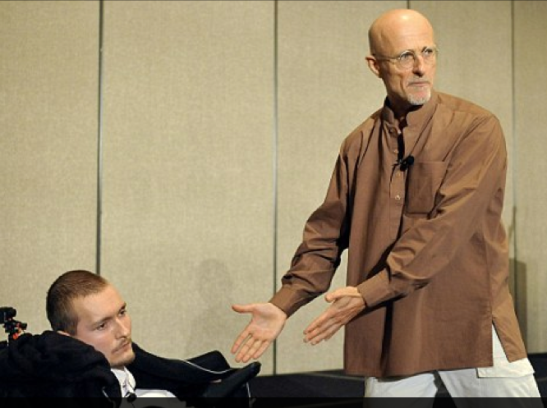Money is pouring in to pay for the world’s first head transplant, says the man who is ready to make history by becoming a human guinea pig. Valery Spiridonov has confirmed major donations have started to arrive, allowing surgeon Sergio Canavero to continue planning the operation to remove his head and place it on another body.
However, Spiridonov – who has a muscle wasting disease – refused to confirm reports that unnamed sponsors have pledged $100million (£64million) for the pioneering surgery, dubbed ‘reckless’ by other medical professionals.
The 30-year-old said: ‘He [Canavero] received several offers, mainly those were people who contacted him through me, because I’m widely seen on the internet.
‘They first contacted me, and then reached out to him.’
The bizarre plan to remove Spirdonov’s head first came to light earlier this year, when the Italian doctor and Russia scientist decided to go public.
Since the, the two have attended a conference together in America to try and convince the medical world that the plan is more than an insane publicity stunt.
There was speculation that the entire thing was an extended publicity stunt for a video game – something which well-known surgeon Canavero has strongly denied. Spiridonov, who suffers from Werdnig-Hoffman disease, a spinal muscular atrophy, explained: ‘If I manage to replace my body and if everything goes well, it will allow me to be free of the limitations I am experiencing.’
He admitted previously: ‘I am not rushing to go under the surgeon’s knife, I am not shouting – come and save me here and now.
‘Yes, I do have a disease which often leads to death, but my first role in this project is not that of a patient.
‘First of all, I am a scientist, I am an engineer, and I am keen to persuade people – medical professionals – that such operation is necessary.
‘I am not going crazy here and rushing to cut off my head, believe me. ‘The surgery will take place only when all believe that the success is 99 per cent possible.
‘In other words, the main task now is to get support for Canavero from the medical community, to let him go on with his methods and to improve them within these two coming years.’
The men hope to carry out the operation in 2017, if ‘all goes according to plan’.
But a leading Russian surgeon, Anzor Khubutia, director of the Moscow-based Sklifosovsky emergency hospital, warned that Canavero’s plans were ‘reckless’.
‘This may be real in the future,’ said Khubutia. ‘But it’s hard to talk about head transplantation before spine regeneration becomes possible.’
Despite doubts like these, Canavero – labelled Dr Frankenstein – insisted in June that the surgery is feasible.
‘The Soviet Union was the first one to send Yuri Gagarin to space, America was the first on the moon. The country that hosts head transplant surgery for the first time will become a leader like this,’ he said.
He vowed to confound doubters and doom-mongers, claiming: ‘I’ll prove it is totally possible.’
‘Valery’s head will be detached from his body and transferred to another one in a matter of seconds, and brain’s blood flow will start in about 15 minutes.’
The feat has been accomplished to some degree for a short time with dogs and a monkey.
On March 14, 1970, a group of scientists from Case Western Reserve University School of Medicine in Cleveland, Ohio, led by Robert J. White, a neurosurgeon and a professor of neurological surgery who was inspired by the work of Vladimir Demikhov, performed a highly controversial operation to transplant the head of one monkey onto another’s body. The procedure was a success to some extent, with the animal being able to smell, taste, hear, and see the world around it. The operation involved cauterizing arteries and veins carefully while the head was being severed to prevent hypovolemia. Because the nerves were left entirely intact, connecting the brain to a blood supply kept it chemically alive. The animal survived for some time after the operation, even at times attempting to bite some of the staff. In 2001, Dr. White successfully repeated the operation on a monkey.
White later wrote:
…What has been accomplished in the animal model – prolonged hypothermic preservation and cephalic transplantation, is fully accomplishable in the human sphere. Whether such dramatic procedures will ever be justified in the human area must wait not only upon the continued advance of medical science but more appropriately the moral and social justification of such procedural undertakings…what has always been the stuff of science fiction – the Frankenstein legend, in which an entire human being is constructed by sewing various body parts together – will become a clinical reality early in the 21st century… brain transplantation, at least initially, will really be head transplantation – or body transplantation, depending on your perspective… with the significant improvements in surgical techniques and postoperative management since then, it is now possible to consider adapting the head-transplant technique to humans.








